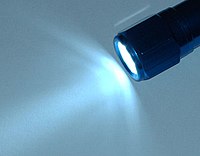
When we saw the
debut of the Philips Lumiblade Mirrorwall prototype last year in a special exhibition during the
Milan Furniture Fair, we fell head over heels for this sophisticated use of lighting technology. The series of linked OLED modules act as a mirror in the off state, and as an interactive lit curtain wall when powered. Well, it's been almost a year since the prototype debut, and
Philips has announced that a version of the mirrorwall, called
Lumiblade Reflections, will be available for sale in limited quantities. The technology is cutting edge, extremely energy efficient, and perfect for the eco-enthusiast looking to splurge on one of these limited edition museum-worthy products.P.S. Thanks to reader
mertero for tipping us off!

Lumiblade tiles use
OLED technology, which allows for a very homogenous surface light. Unlike LEDs, this light will never have those pesky hot spots. OLEDs work by passing low levels of electricity through thin layers of
organic semiconductor materials. In other words, the tiles are a stack-up of films that can be electrically charged, causing them to become “excited” and emit light. Right now, the tile sizes are limited in size, but they can be linked together into endless configurations.
OLEDs are superior to LEDs in their even output, their flat form, and their minimal circuitry required for powering. OLED is extremely energy efficient with ratings for white modules providing up to 15 lumens per watt. Efficiencies depend highly on the colors, with white being the most efficient. Similar to
LED technology blue emitters still have room for improvement, while green is also highly efficient. Certification bodies, such as
Energy Star, typically rate lighting efficiency by
efficacy, which is a ratio of lumens per watt. The white Lumiblade tiles provide approximately 15 lm/W. This is a great rating considering that these tiny tiles output 1000
candelas for up to 10,000 hours. As a comparison, the efficacy of a Philips 100 watt incandescent bulb is about 14 lm/watt, but only gives off 120 candelas for a lifespace of about 750-1000 hours.

In an off state, it is possible for the OLED tiles to be transparent, since the materials on the layers of sandwiched films appear to be clear. A mirror-like appearance, like that of the Lumiblade Reflections, can also be achieved by using specialty layers in the stack-up. The added feature that makes Lumiblade Reflections so outstanding is that it is interactive. The tiles have
infrared sensors behind the illuminated panels that detect an object or presence, so when an object passes in front of the tiles, the OLED face dims to a mirrored surface. If one were to stand in front of the mirror, the tiles around their silhouette would stay illuminated, allowing for a very functional mirror and light in one!
In a Philips newsletter, it states that the special edition Lumiblade Reflections would cost approximately 5000€ ($6,798USD), which may not be practical for a household mirror for grooming your locks, but it sure would be a wonderful art piece. We have to consider that this is only the beginning for explorations in OLED technology and
responsive lighting. Even though these first editions may not be in financial reach for all, the fact that they are commercially available suggests that we will see this technology translated to bathroom products, furniture, mirrors, and other household good in the near future.











 Candace Lombardi, a freelance journalist based in the Boston area, focuses on the evolution of green and otherwise cutting-edge technologies, from robots to cars to scientific innovation. She is a member of the CNET Blog Network and is not a current employee of CNET.
Candace Lombardi, a freelance journalist based in the Boston area, focuses on the evolution of green and otherwise cutting-edge technologies, from robots to cars to scientific innovation. She is a member of the CNET Blog Network and is not a current employee of CNET.
























